I was originally going to have only one post about Out of Africa, but when I’d written over 2,000 words and still had more to say, I decided to present the tale in more manageable chunks.
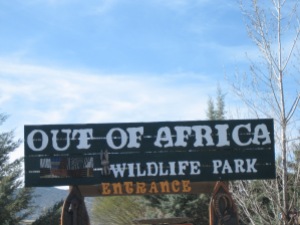 Out of Africa is a wildlife park in Camp Verde, Arizona. You can find out everything you want to know about it here: http://outofafricapark.com/.
Out of Africa is a wildlife park in Camp Verde, Arizona. You can find out everything you want to know about it here: http://outofafricapark.com/.
I’m not a big fan of zoos, and I don’t think I’ve ever been to a wildlife park. I mainly decided to visit Out of Africa because the park grants visitors free admission during their birthday month. My birthday is in February and so is Nolagirl’s so we decided we should go together when we could both get in for free. Also along on the trip were Nolagirl’s daughter LIttle Phoenix and her friend Izzy.
(Sidenote: Earlier in the week, I’d gone to the Goodwill Clearance Center and found four tutus. I bought them and brought them with me when I met the gals before our trip to Out of Africa. I was so pleased by the excitement the tutus caused. Each of the ladies chose one and wore it for the whole day. We quickly began referring to ourselves as “the Tutu Gang.” We received several compliments on our attire and had a lot of fun dressing up.)
After stopping at the ticket office and paying for the girls and picking up our pink happy birthday bracelets, we headed directly to the African Bush Safari Tour. Visitors filed onto a safari tram with no windows and prepared to meet animals up close and personal. Our guide (and driver of the tram) was Lauren.
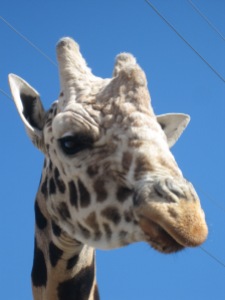 We stopped first to feed a giraffe named Pilgrim. Lauren told us giraffes naturally have no top teeth, so it is safe for people to feed them. (We were told that zebras, on the other hand, have very strong top and bottom teeth and should not be fed by hand. We were told that if we held five fingers out to a zebra, we were likely to have fewer fingers when we withdrew our hand.)
We stopped first to feed a giraffe named Pilgrim. Lauren told us giraffes naturally have no top teeth, so it is safe for people to feed them. (We were told that zebras, on the other hand, have very strong top and bottom teeth and should not be fed by hand. We were told that if we held five fingers out to a zebra, we were likely to have fewer fingers when we withdrew our hand.)
Everyone in the tram had been given a slender green leafy plant to offer to Pilgrim. He knew the routine and he was waiting for his treats when the tram approached his living area.
We were told that Pilgrim doesn’t like having his face touched and would get upset if we tried to touch it, so we didn’t get to pet him. Being able to feed him was so cool; it was ok that I didn’t get to pet him too. Now I can tell people that I’ve fed a giraffe!
Pilgrim is not the only giraffe that lives in Out of Africa. There is another male, Kibo, who lives there too. The two giraffes were once good friends, but they started fighting over an “imaginary girlfriend,” and now have to live separately.
After feeding Pilgrim, we continued on our African Bush Safari Tour. The tram went through a gate, and we rode around in an area where visitors are not allowed to walk. Although the animals are in captivity, they are still wild, and they could easily hurt people who don’t know how to act around them.
The critters below in particular could do some damage. That is a sable antelope. According to Wikipedia, sable antelopes “inhabit wooded savannah in East Africa south of Kenya and in Southern Africa.” How about another look at those horns?
That is a sable antelope. According to Wikipedia, sable antelopes “inhabit wooded savannah in East Africa south of Kenya and in Southern Africa.” How about another look at those horns? 
Unlike most other types of antelope (and deer, elk, etc.) the sable antelope won’t try to run from a predator. Here’s Wikipedia again: “When sable antelopes are threatened by [a] predator, including lions, they confront it, using their scimitar-shaped horns. Many of these big cats have died during such fights.” That’s what our tour guide told us too. If this creature is not taking any shit from a lion, do you think it’s going to put up with some stupid human with a camera acting a fool in its face? I think not. That’s why the stupid humans with the cameras had to stay in the tram.
Next we saw zebras.
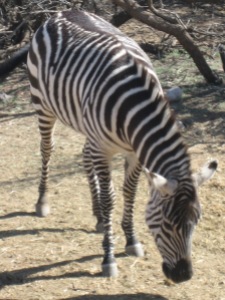 I didn’t see any people sticking their hands out of the tram to see how many fingers they would end up with if they offered five to a zebra.
I didn’t see any people sticking their hands out of the tram to see how many fingers they would end up with if they offered five to a zebra.
We learned that zebras are black with white stripes. The clue is that the nose of a zebra is black. Apparently, zebras are entirely black under their fur!
 One thing that amazed me about Out of Africa is that the human caregivers recognize each animal individually and by name. While visitors just see a group of zebras milling about, members of the Out of Africa staff know each animal’s name and story. Our guide told us about one young zebra who’s having a bit of an identity crisis. She doesn’t want to hang out with the other zebras. Instead, she’s been hanging out with the other animals in the African Bush area. She’s trying out living with other animals so she can decide what kind of critter she wants to be!
One thing that amazed me about Out of Africa is that the human caregivers recognize each animal individually and by name. While visitors just see a group of zebras milling about, members of the Out of Africa staff know each animal’s name and story. Our guide told us about one young zebra who’s having a bit of an identity crisis. She doesn’t want to hang out with the other zebras. Instead, she’s been hanging out with the other animals in the African Bush area. She’s trying out living with other animals so she can decide what kind of critter she wants to be! 
The photo to the left is of a baby zebra. I believe it was just a few weeks old when I visited. The black stripes on zebras start out brown and get darker as the zebra gets older. Zebras moms are pregnant for 13 months, and baby zebras weigh about 70 pounds when they are born.
 The photo on the left shows an addax. It’s got some pretty groovy horns too. But I don’t think it fights lions.
The photo on the left shows an addax. It’s got some pretty groovy horns too. But I don’t think it fights lions.
The animal to the right is one of the watusi (ankole cattle).  These were the last animals we saw on the African Bush Safari Tour.
These were the last animals we saw on the African Bush Safari Tour.
We also saw a camel named Humphrey and an ostrich named Chili-Pepper on the African Bush Safari Tour. Both Chili-Pepper and Humphrey live alone in separate enclosures because they don’t get along with any other animals. When we stopped to see Chili-Pepper, Lauren got out of the bus to interact with her. Lauren showed us how ostriches will instinctively jab their heads at anything right in front of them. She warned us that we did not want Chili-Pepper to hit us with her beak, and suggested we just move out of her range if she approached the tour bus. Lauren also told us that if threatened, an ostrich would not defend itself with its beak. If it could not run away (ostriches run extremely fast), it would fight by delivering a powerful kick and use its inner toe to cut open the enemy.
To read about the predators at Out of Africa, go here: http://www.rubbertrampartist.com/2015/06/03/out-of-africa-part-2/.
All of the photos in this post were taken by me.

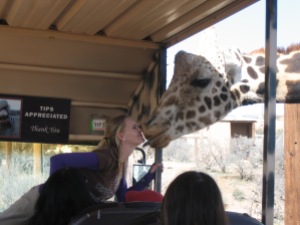


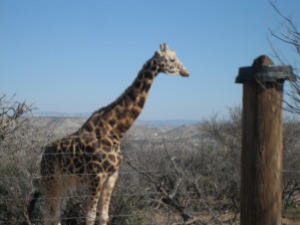

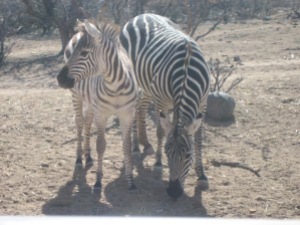

This on the morning news- woman killed by lion-had window open
http://www.cnn.com/2015/06/01/africa/south-africa-lion-attack/
At Out of Africa, there are fences between the predators and the public.
Lady should have rolled up her window!
Pingback: Out of Africa, Part 2 | Rubber Tramp Artist